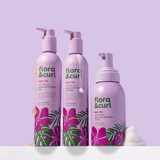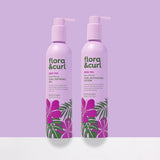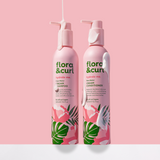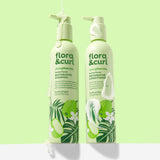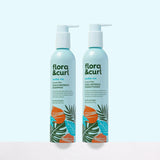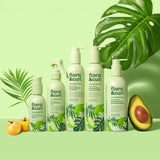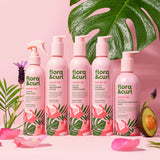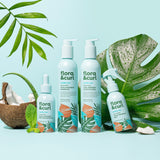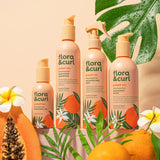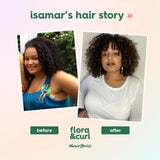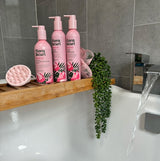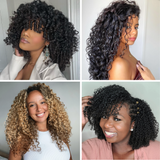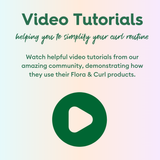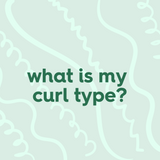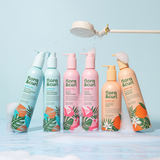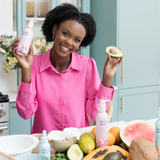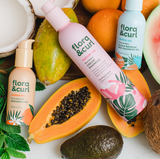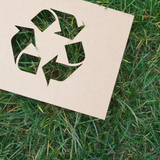

Colouring the hair is fun! And we completely understand with all of this free time we have on our hands we can dye our hair whatever colour because… Who is going to see us if it looks bad? No one. Maybe Mr and Mrs Smith from next-door, but that’s okay. The next day you can just dye it back to normal (cues incorrect buzzer).
You see curlfriends, before colour dying your hair it is so crucial to ensure we have a healthy foundation of hair to begin with. As I am sure you are aware of when Aunt Maisie dyed her hair – the damage showed on her once was luscious locks. This is because the chemicals in hair dye can tarnish the hair fibres if you have not already got healthy hair and a moisture enriched regime.
Before Taking the Plunge
So, what are the differences between hair dyes? The first thing to note is that there are three main types:

1. Permanent
Permanent colouring consists of using hydrogen peroxide and ammonia-based products. This method of dying is required when wanting to drastically and permanently dye the hair.
The hydrogen peroxide and ammonia molecules lift the cuticle layers of the hair to allow for colour deposition. This ensures that it will stay in the hair permanently. The coloured molecules that start smaller will then expand in the hair shaft and allows for the colour to not wash out.
2. Semi-permanent
Semi-permanent hair colours are less damaging to the hair fibres due to the scientific formulation of molecules.
The molecules are much larger and cannot completely penetrate the hair shaft; this is also because it deposits colour only and partially penetrates. However, semi-permanent hair colours tend to be more effective with darkening textured tresses more so than lifting/lightening.
3. Temporary Colour Rinses
The safest way to dye your hair is with a temporary colour rinse. Although you are limited to colour choice, it is an effective method to use on either already dyed hair to help protect the cuticle layers of the hair or it can simply help make the hair look enriched, darker and glossier.
Regarding its molecular formulation, temporary colour rinses’ molecules are so large that it can only coat the outside of those cuticle layers. The molecules are simply too large to enter the cortex of the hair shaft. Additionally, temporary colour rinses are only useful for darkening and not lightening the hair. These type of hair colours imitate behaviours of protein-based products and are brilliant protectors of the cuticle layer.
Practice Makes Better
Some of us here at Flora & Curl have coloured curls too! Here is our coloured-curl specific regimen that will enrich those curls, nourish those ends and revitalise those roots.

1. Detangle!
Simply detangle the hair with the Gentle Curl Comb and start from the bottom upwards to get the knots out. If your knots resemble Bob Marley’s dreadlocks, you can always use our Rose Water Detangling Lotion. Our Rose Water Curl Mist will further help the brush/comb go through the hair.
2. Pre-Poo
Pre-pooing will make all the difference on wash day. Give those thirsty curlies some hydration and moisture before washing. We advise using our Citrus Superfruit Radiance Oil to pre-poo. Simply section the hair in either four or more twists or plaits and ensure each section gets a healthy dose of our hair oil. Ensure your scalp gets that moisture and hydration from the products – for hair to get to parts of the scalp, simply spritz the Rose Water Curl Mist.
3. Post Pre-Poo
Once you have plaited/twisted the hair into sections tie the hair up (leaving plaits/twists in) with the Vegan Satin Scrunchies.
4. Time to Shampoo
Unravel your twists and plaits and wash with our Rose Water Cream Shampoo. Our shampoo will revitalise the hydration within the hair and scalp and provide a gentle yet cleansing lather to help lift product residue from the scalp.
5. Deep Condition
After you have thoroughly washed and rinsed the hair, simply blot gently the water droplets and apply our Rose Water Cream Conditioner. To complete a 15-minute deep condition. Rinse thoroughly the remaining conditioner with just water, detangle with fingers and then towel blot with the Gentle Curl Towel – this doesn’t need to be completely dry.
6. Styling!
Our favourite part of wash day. We can finally see how changing regimens affect the hair and its curl patterns for the greater good! We advise using our Sweet Hibiscus Curl Activating Lotion as a primer to our Sweet Hibiscus Curl Defining Gel. The lotion will provide a great moisture base for the protein to be applied on top.
#7 Air-dry or Blow-dry?
Heat, when you don’t need it, is unnecessary. Don’t deprive those curls if you don’t need to. Luckily, in quarantine, we don’t have many places to go so now is the perfect time to allow your hair to naturally dry and form beautiful, bouncy curls and coils!
Team Flora & Curl
Continue Reading
-
Sep 25th 2025After three years in the making, it’s finally here! We are proud to announce the launch of our most anticipated collection yet: the Strengthen Me r...
-
Aug 29th 2025
3 Summer Recovery Tips for Curls
The summer sun can leave curls feeling dry and dull. Discover our 3 simple tips to restore the hydration, shine, and bounce back to your curls. -
Dec 11th 2024
Top 5 Must-Have Haircare Products to Stock Up on This Season
This season, stock up on these top 5 Flora & Curl essentials to give your curls the nourishment and definition they deserve. -
Nov 20th 2024
How To Shop Responsibly This Black Friday
This year, we invite you to make a conscious choice when it comes to your beauty regime, particularly in sustainable haircare. -
Nov 15th 2024
Why Scalp Care Is Important
While we often focus on the hair itself, the health of our scalp plays an important role in achieving healthy hair. A well cared-for scalp not only... -
Oct 30th 2024
Mousse VS Foam: What is the Difference?
When it comes to styling textured hair, the choice in the product you use can make all the difference. In this post, we’ll dive deep into the diffe...
